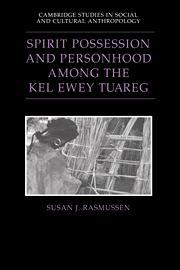Book contents
- Frontmatter
- Contents
- Acknowledgments
- Introduction
- 1 Illnesses of the heart and soul: the case of Asalama
- PART I Images of possession
- 2 Inversion and other tropes in spirit possession rituals
- 3 “Like a tree branch swaying in the wind”: the head dance
- 4 Illnesses of God: personhood, knowledge, and healing
- PART II Art, agency, and power in the ritual sessions
- Conclusions
- Notes
- References
- Index
- Cambridge Studies in Social and Cultural Anthropology
3 - “Like a tree branch swaying in the wind”: the head dance
Published online by Cambridge University Press: 11 November 2009
- Frontmatter
- Contents
- Acknowledgments
- Introduction
- 1 Illnesses of the heart and soul: the case of Asalama
- PART I Images of possession
- 2 Inversion and other tropes in spirit possession rituals
- 3 “Like a tree branch swaying in the wind”: the head dance
- 4 Illnesses of God: personhood, knowledge, and healing
- PART II Art, agency, and power in the ritual sessions
- Conclusions
- Notes
- References
- Index
- Cambridge Studies in Social and Cultural Anthropology
Summary
In possession, tropes, aesthetic form, and the social expression of power are interrelated. This is illustrated most clearly in the multivocality of the central simile or motif appearing in possession imagery that is also pervasive throughout Tuareg visual and verbal arts: a balanced swaying to and fro, compared metaphorically to “a tree branch swaying in the wind.” This image in art, associated with femininity and nobility, is idealized as the “most beautiful” aesthetic style. It recurs in song and poetry, in the drum pattern called talawankan, in dress style, in the fringe and tassels of leatherwork, and in the sideways “head dancing” performed by the woman in trance. Outside possession, it appears in the popular men's dances dilélé lé and achelub-chelub, as they approach a chorus of women at festivals. In addition, this image is used to describe altered emotional states.
This association between verbal, visual, and kinesthetic modes of understanding is demonstrated in the head dance, viewed against the backdrop of Tuareg visual arts and spatial/temporal orientations. Both within and outside the possession setting, these mixed codes interlock. The singing of women is considered incomplete without the shouts of men; storytelling is accompanied by the hand gestures of the teller; and some instruments must be played together, such as the asakalabo and the t∂nde.
- Type
- Chapter
- Information
- Publisher: Cambridge University PressPrint publication year: 1995



